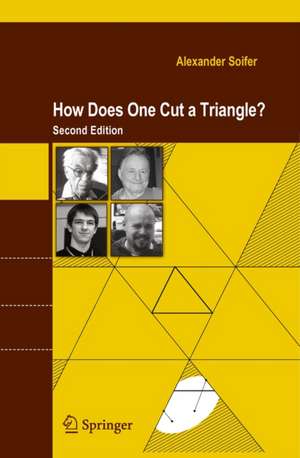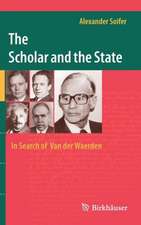How Does One Cut a Triangle?
Autor Alexander Soiferen Limba Engleză Paperback – 10 sep 2009
How Does One Cut a Triangle? contains dozens of proofs and counterexamples to a variety of problems, such as a pool table problem, a fifty-dollar problem, a five-point problem, and a joint problem. By proving these examples, the author demonstrates that research is a collection of mathematical ideas that have been developed throughout the course of history.
The author brings mathematics alive by giving the reader a taste of what mathematicians do. His book presents open problems that invite the reader to play the role of the mathematician. By doing so, the author skillfully inspires the discovery of uncharted solutions using his solutions as a guide.
Preț: 349.74 lei
Nou
Puncte Express: 525
Preț estimativ în valută:
66.93€ • 69.35$ • 55.86£
66.93€ • 69.35$ • 55.86£
Carte tipărită la comandă
Livrare economică 21 martie-04 aprilie
Preluare comenzi: 021 569.72.76
Specificații
ISBN-13: 9780387746500
ISBN-10: 0387746501
Pagini: 174
Ilustrații: XXX, 174 p. 83 illus.
Dimensiuni: 155 x 235 x 11 mm
Greutate: 0.3 kg
Ediția:2nd ed. 2009
Editura: Springer
Colecția Springer
Locul publicării:New York, NY, United States
ISBN-10: 0387746501
Pagini: 174
Ilustrații: XXX, 174 p. 83 illus.
Dimensiuni: 155 x 235 x 11 mm
Greutate: 0.3 kg
Ediția:2nd ed. 2009
Editura: Springer
Colecția Springer
Locul publicării:New York, NY, United States
Public țintă
Lower undergraduateCuprins
The Original Book.- A Pool Table, Irrational Numbers, and Integral Independence.- How Does One Cut a Triangle? I.- Excursions in Algebra.- How Does One Cut a Triangle? II.- Excursion in Trigonometry.- Is There Anything Beyond the Solution?.- Pursuit of the Best Result.- Convex Figures and the Function S().- Paul Erd#x0151;s: Our Joint Problems.- Convex Figures and Erd#x0151;os#x2019; Function S().- Developments of the Subsequent 20 Years.- An Alternative Proof of Grand Problem II.- Mikl#x00F3;s Laczkovich on Cutting Triangles.- Matthew Kahle on the Five-Point Problem.- Soifer#x2019;s One-Hundred-Dollar Problem and Mitya Karabash.- Coffee Hour and the Conway#x2013;Soifer Cover-Up.- Farewell to the Reader.
Recenzii
From the reviews of the second edition:
“In the second edition of an engagingly written book … addressed to bright high school students and undergraduates, whose contributions are very nicely incorporated into the narrative, the author presents problems belonging to discrete and combinatorial geometry.” (Victor V. Pambuccian, Zentralblatt MATH, Vol. 1180, 2010)
“How does one cut a triangle? is a charming little book intended for that most rare of readers: one with little or no knowledge of mathematics above the high school level … . For such a reader, this book constitutes an opportunity to learn a number of mathematical tools and problem-solving techniques. … overall there is much in this book to commend it to both expert and novice … .” (Michael Weiss, Mathematical Reviews, Issue 2011 c)
“In the second edition of an engagingly written book … addressed to bright high school students and undergraduates, whose contributions are very nicely incorporated into the narrative, the author presents problems belonging to discrete and combinatorial geometry.” (Victor V. Pambuccian, Zentralblatt MATH, Vol. 1180, 2010)
“How does one cut a triangle? is a charming little book intended for that most rare of readers: one with little or no knowledge of mathematics above the high school level … . For such a reader, this book constitutes an opportunity to learn a number of mathematical tools and problem-solving techniques. … overall there is much in this book to commend it to both expert and novice … .” (Michael Weiss, Mathematical Reviews, Issue 2011 c)
Textul de pe ultima copertă
How Does One Cut a Triangle? is a work of art, and rarely, perhaps never, does one find the talents of an artist better suited to his intention than we find in Alexander Soifer and this book.
—Peter D. Johnson, Jr.
This delightful book considers and solves many problems in dividing triangles into n congruent pieces and also into similar pieces, as well as many extremal problems about placing points in convex figures. The book is primarily meant for clever high school students and college students interested in geometry, but even mature mathematicians will find a lot of new material in it. I very warmly recommend the book and hope the readers will have pleasure in thinking about the unsolved problems and will find new ones.
—Paul Erdös
It is impossible to convey the spirit of the book by merely listing the problems considered or even a number of solutions. The manner of presentation and the gentle guidance toward a solution and hence to generalizations and new problems takes this elementary treatise out of the prosaic and into the stimulating realm of mathematical creativity. Not only young talented people but dedicated secondary teachers and even a few mathematical sophisticates will find this reading both pleasant and profitable.
—L.M. Kelly
Mathematical Reviews
[How Does One Cut a Triangle?] reads like an adventure story. In fact, it is an adventure story, complete with interesting characters, moments of exhilaration, examples of serendipity, and unanswered questions. It conveys the spirit of mathematical discovery and it celebrates the event as have mathematicians throughout history.
—Cecil Rousseau
The beginner, who is interested in the book, not only comprehends a situation in a creative mathematical studio, not only is exposed to good mathematical taste, but also acquires elements of modernmathematical culture. And (not less important) the reader imagines the role and place of intuition and analogy in mathematical investigation; he or she fancies the meaning of generalization in modern mathematics and surprising connections between different parts of this science (that are, as one might think, far from each other) that unite them.
—V.G. Boltyanski
SIAM Review
Alexander Soifer is a wonderful problem solver and inspiring teacher. His book will tell young mathematicians what mathematics should be like, and remind older ones who may be in danger of forgetting.
—John Baylis
The Mathematical Gazette
—Peter D. Johnson, Jr.
This delightful book considers and solves many problems in dividing triangles into n congruent pieces and also into similar pieces, as well as many extremal problems about placing points in convex figures. The book is primarily meant for clever high school students and college students interested in geometry, but even mature mathematicians will find a lot of new material in it. I very warmly recommend the book and hope the readers will have pleasure in thinking about the unsolved problems and will find new ones.
—Paul Erdös
It is impossible to convey the spirit of the book by merely listing the problems considered or even a number of solutions. The manner of presentation and the gentle guidance toward a solution and hence to generalizations and new problems takes this elementary treatise out of the prosaic and into the stimulating realm of mathematical creativity. Not only young talented people but dedicated secondary teachers and even a few mathematical sophisticates will find this reading both pleasant and profitable.
—L.M. Kelly
Mathematical Reviews
[How Does One Cut a Triangle?] reads like an adventure story. In fact, it is an adventure story, complete with interesting characters, moments of exhilaration, examples of serendipity, and unanswered questions. It conveys the spirit of mathematical discovery and it celebrates the event as have mathematicians throughout history.
—Cecil Rousseau
The beginner, who is interested in the book, not only comprehends a situation in a creative mathematical studio, not only is exposed to good mathematical taste, but also acquires elements of modernmathematical culture. And (not less important) the reader imagines the role and place of intuition and analogy in mathematical investigation; he or she fancies the meaning of generalization in modern mathematics and surprising connections between different parts of this science (that are, as one might think, far from each other) that unite them.
—V.G. Boltyanski
SIAM Review
Alexander Soifer is a wonderful problem solver and inspiring teacher. His book will tell young mathematicians what mathematics should be like, and remind older ones who may be in danger of forgetting.
—John Baylis
The Mathematical Gazette
Caracteristici
Aims to inspire talented students at various levels and other mathematicians interested in similar problems Offers insight on different problem solving methods used to attack the problem, “How Does One Cut a Triangle?” Presents example problems and solutions as well as open problems Engages a general audience Includes supplementary material: sn.pub/extras















